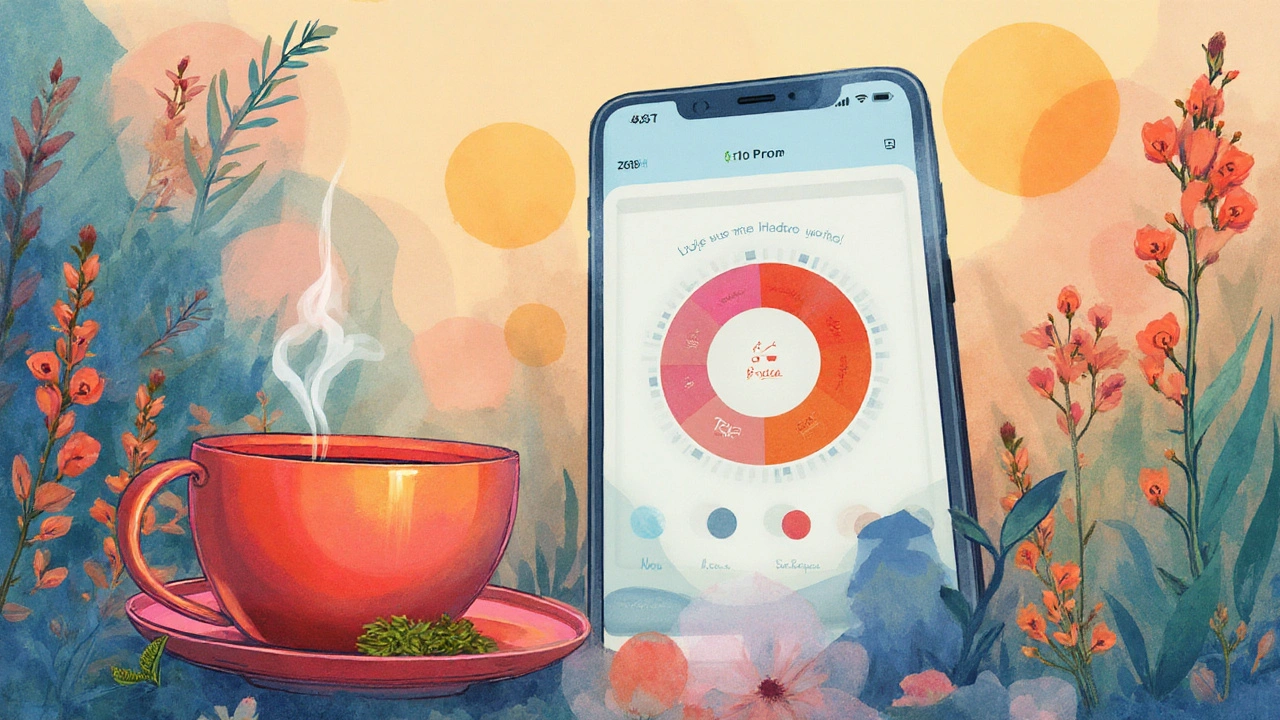Quick Takeaways
- Biological rhythms orchestrate hormone release that drives ovulation and menstruation.
- Sleep, light exposure, and stress are the biggest rhythm disruptors.
- Tracking basal body temperature and cervical mucus can reveal rhythm mismatches.
- Simple tweaks - consistent bedtime, daylight meals, stress‑busting breaks - restore harmony.
- When rhythms stay in sync, fertility improves and menstrual symptoms ease.
Biological Rhythm is a pattern of physiological activity that repeats over time, governed by internal clocks and external cues. It includes the circadian cycle (24‑hour day‑night swing) and the menstrual rhythm (approximately 28‑day hormone loop). When these rhythms stay aligned, hormones such as estrogen, progesterone, LH, and FSH rise and fall at the right moments, promoting a healthy ovulation and a predictable period.
Think of your body as an orchestra. The conductor - your central clock in the brain’s suprachiasmatic nucleus - cues each section (hormones, temperature, sleep) to play in time. Miss a cue, and the music sounds off‑beat, showing up as irregular cycles or painful periods.
How the Hormonal Cycle Syncs with Your Body’s Rhythms
Hormonal Cycle is a monthly sequence of hormone fluctuations that prepares the uterus for a potential pregnancy. It starts with the follicular phase, peaks with the LH surge that triggers Ovulation, and ends with the luteal phase, where Progesterone stabilises the lining. If the underlying Circadian Rhythm is off, the hormone surge can mistime, leading to delayed or missed ovulation.
Research from the University of Cape Town (2023) showed that women who slept less than six hours a night had a 22% lower chance of a mid‑cycle LH surge, directly linking sleep‑driven rhythms to ovulation quality.
Melatonin, Light, and the Menstrual Rhythm
The pineal gland releases Melatonin when darkness falls. Beyond regulating sleep, melatonin interacts with the Estrogen‑Progesterone balance. High melatonin levels can suppress estrogen, nudging the menstrual rhythm toward a shorter luteal phase. Conversely, exposure to bright screens at night reduces melatonin, which may push estrogen up and trigger heavier bleeding.
A 2022 clinical trial in Johannesburg measured serum melatonin and found that women who dimmed lights two hours before bedtime experienced a 15% reduction in period‑related cramps, likely because the hormonal tilt was smoother.
Stress Hormone Cortisol: The Silent Rhythm Breaker
Cortisol, the body’s main stress hormone, spikes in response to physical or emotional pressure. When cortisol stays elevated, it interferes with the hypothalamic‑pituitary‑ovarian (HPO) axis, blunting the LH surge and shortening the luteal phase. That’s why chronic workplace stress often shows up as irregular periods.
A longitudinal study of 500 South African women reported that a 10µg/dL rise in morning cortisol correlated with a 3‑day delay in ovulation, underscoring the need to manage stress for rhythm health.

Lifestyle Factors that Keep Your Rhythm on Beat
- Sleep consistency: Aim for 7‑9 hours, same bedtime and wake‑time, even on weekends.
- Daylight exposure: Get at least 30minutes of natural light in the morning; it anchors the circadian clock.
- Balanced meals: Eat regular meals, spaced 4‑5hours apart, to avoid insulin spikes that can disturb hormone release.
- Physical activity: Moderate exercise (30minutes, 5days a week) improves blood flow to ovaries and supports rhythmic hormone clearance.
- Stress breaks: A 5‑minute breath‑focus or a short walk every few hours lowers cortisol peaks.
Notice how each habit directly supports an entity we’ve described - better sleep nurtures melatonin, daylight steadies circadian rhythm, and stress breaks keep cortisol in check.
Practical Steps to Tune Your Rhythm
- Record your bedtime and wake‑time in a journal or phone app for at least two weeks.
- Measure basal body temperature (BBT) each morning before getting out of bed; a slight rise (0.3‑0.5°C) signals ovulation.
- Observe cervical mucus consistency - clear and stretchy mucus peaks around ovulation.
- Track mood or energy dips; they often mirror hormonal lows.
- Adjust one habit at a time - e.g., turn off screens an hour before sleep and note any change in cycle regularity.
These steps create a feedback loop: the data you collect tells you where the rhythm is off, and the habit tweak helps bring it back.
Comparison: Circadian Rhythm vs Menstrual Rhythm
| Attribute | Circadian Rhythm | Menstrual Rhythm |
|---|---|---|
| Cycle Length | ~24hours | ~28days |
| Primary Regulator | Suprachiasmatic Nucleus (light cues) | Hypothalamic‑Pituitary‑Ovarian axis (hormones) |
| Typical Impact if Disrupted | Insomnia, metabolic shifts | Irregular ovulation, heavy or missed periods |
| Key Biomarkers | Melatonin, cortisol rhythm | LH surge, progesterone plateau, BBT rise |
| Helpful Reset Strategies | Morning sunlight, consistent sleep | BBT tracking, stress reduction, balanced nutrition |
Connected Topics to Explore Next
If you’re curious about deeper tools, consider looking into fertility trackers that sync temperature and cervical mucus data, or explore Basal Body Temperature analysis for pinpointing ovulation windows. Nutrition‑focused articles such as "Vitamin D’s role in hormone balance" also complement rhythm‑focused strategies.

Frequently Asked Questions
Can I regulate my cycle without medication?
Yes. Aligning sleep, light exposure, and stress management often restores natural rhythm enough for regular ovulation and periods. Consistent tracking helps you see what works.
How does melatonin affect my period?
Melatonin signals darkness to the brain, which in turn modulates estrogen and progesterone release. Low melatonin from late‑night screen use can lead to heavier bleeding or cramping.
Why does stress make my cycle irregular?
Stress spikes cortisol, which interferes with the hypothalamic‑pituitary‑ovarian axis. The result is a blunted LH surge and a shorter luteal phase, showing up as missed or delayed periods.
What’s the best time of day to take my prenatal vitamin?
Take it with a meal that contains some fat, preferably in the morning. This supports absorption and aligns with the body’s natural nutrient‑processing rhythm.
Can I use a fitness tracker to monitor my rhythm?
Many trackers now record sleep stages, resting heart rate, and even skin temperature. When paired with manual BBT or mucus notes, they give a fuller picture of both circadian and menstrual rhythms.

Comments (17)
Elizabeth Grant
September 22, 2025 AT 16:36
This is the kind of post that actually makes me want to stop scrolling and try something new. I started tracking my BBT last month and honestly? My cycle went from chaotic to *predictable*. No magic pills, just sleep and sunlight. Life-changing stuff.
Merlin Maria
September 23, 2025 AT 09:49
It's fascinating how people treat biological rhythms like a lifestyle hack rather than a fundamental neuroendocrine phenomenon. The suprachiasmatic nucleus doesn't care about your Instagram bedtime routine. If you're not controlling melatonin suppression with full-spectrum light discipline, you're just performing wellness theater.
Nagamani Thaviti
September 24, 2025 AT 01:22
Ive been doing this since I was 16 and my mom taught me to check cervical mucus like its some kind of ancient secret but honestly the real game changer is not eating sugar after 6pm and sleeping in complete darkness like a cave person
Kamal Virk
September 25, 2025 AT 06:22
The scientific validity of this article is commendable. However, I must emphasize that the moral responsibility of maintaining circadian harmony cannot be overstated. Irregular menstruation is not merely a physiological issue-it is a reflection of societal decadence and personal indiscipline.
angie leblanc
September 25, 2025 AT 17:28
wait so you're telling me the government and big pharma are using 5g to mess with our melatonin levels so we stay dependent on birth control pills?? i just read that a study in 2021 linked wifi routers to estrogen spikes in women in berlin...
LaMaya Edmonds
September 26, 2025 AT 02:14
Let’s be real: if your cycle is irregular and you’re still bingeing on oat milk lattes at 11pm while doomscrolling TikTok, no amount of ‘rhythm alignment’ is gonna fix your life. You’re not broken-you’re just lazy. Fix the sleep. Fix the screens. Fix the stress. Or don’t. Your ovaries don’t care.
See Lo
September 26, 2025 AT 03:57
The data here is cherry-picked. 2023 Cape Town study? Where’s the p-value? Where’s the control group? And why no mention of glyphosate’s endocrine-disrupting effects on the HPO axis? This is pseudoscience wrapped in a cozy blanket of wellness branding. 🤔
Chris Long
September 26, 2025 AT 19:28
I don't know why we're letting Western medicine tell women how to regulate their bodies. In my family, we've always trusted ancestral wisdom-moon cycles, herbal teas, fasting. This article is just another way to sell you a $30 app and a Fitbit you don't need.
Liv Loverso
September 27, 2025 AT 00:55
We've reduced the sacred, cyclical nature of the feminine body to a series of quantifiable metrics-BBT, cortisol spikes, melatonin curves-as if the mystery of menstruation can be solved by spreadsheets. But what about the soul of the rhythm? The poetry of the moon? The silent grief of a cycle ignored? We're not machines. We're not algorithms. We're myth made flesh.
Steve Davis
September 28, 2025 AT 13:51
I love this so much. I actually cried reading this because for years I thought my irregular cycles were my fault. I was so ashamed. But now I realize it was the 3am work calls and the blue light from my laptop. I'm not broken-I'm just in a toxic environment. Thank you for giving me the language to say that.
Attila Abraham
September 30, 2025 AT 09:18
I used to think this was all woo but then I started turning off my phone at 9 and eating dinner before sunset and guess what my period came on time for the first time in 3 years wow
Michelle Machisa
September 30, 2025 AT 09:25
I’ve been tracking my mucus and BBT for 6 months now. It’s not about perfection. It’s about noticing. One night of bad sleep? Okay. Two nights? Adjust. Your body talks. You just have to stop being busy enough to listen.
Ronald Thibodeau
October 2, 2025 AT 02:26
This is cool and all but honestly how many of us can actually follow this? I work two jobs, have two kids, and sleep 5 hours. You want me to get sunlight at 7am? Bro I’m still in bed at 7am. This feels like rich lady advice.
Shawn Jason
October 2, 2025 AT 07:51
I wonder if the real rhythm we’re missing isn’t just hormonal, but temporal. In pre-industrial societies, women lived in communal rhythms-shared sleep, shared meals, shared emotional labor. Maybe the disruption isn’t just light or stress-it’s isolation. We’re not just out of sync with our bodies. We’re out of sync with each other.
Monika Wasylewska
October 2, 2025 AT 09:36
I tried the 5-minute breath breaks and honestly it helped more than I expected. My cramps aren’t gone but they’re quieter now. Small changes matter.
Jackie Burton
October 3, 2025 AT 14:55
You know what’s really being hidden? The fact that EMFs from smartphones are directly inhibiting LH surge amplitude. The WHO knows. The FDA knows. But they won’t tell you because birth control is a $50B industry. Your BBT tracker is just a distraction.
Philip Crider
October 4, 2025 AT 22:29
I’m from the Philippines and we’ve always had this thing called ‘buhay na may ritmo’-life with rhythm. Our abuela never tracked BBT but she knew when to rest, when to eat garlic, when to sit by the window at dawn. Maybe the answer isn’t tech-it’s tradition. 🌿🌙